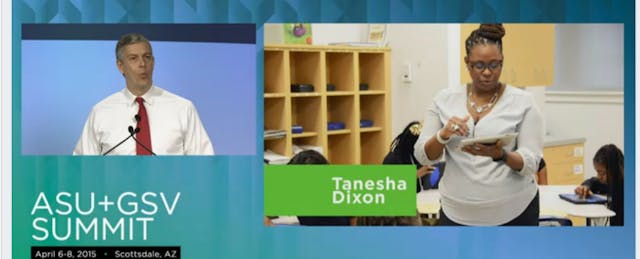To the 2,500 or so people attending the most financially savvy education conference on the planet, Secretary of Education Arne Duncan had one message: Build edtech tools to promote equity.
On the second day of the ASU-GSV Summit in Scottsdale, AZ, Duncan urged entrepreneurs to build products that address the aching problems of low-income students and families, that support principals and teachers, and that promote equity. “Technology has the power to drive equity,” Duncan said. “But it can also widen the lead of those who have an advantage. If the technology revolution only happens for families who have money – I don’t think it’s revolution.”
To underscore his point, Duncan today released its “Ed Tech Developer’s Guide,” intended to be a primer for developers, startups and entrepreneurs. The 60+ page report includes sections on getting started, finding initial funding, honoring the privacy of student data, working with districts, software interoperability, and current trends in education technology. (And we’re proud to notice that EdSurge is on the top of the guide’s list of “Keeping up with Ed Tech” resources.)
Duncan told two stories to personalize who edtech developments should be designed to help: Rashon Johnson is a student whose mother works two jobs; he often winds up using technology at school or playing games with his mother's phone. "Technology is a tool of distraction--not discovery," Duncan said. "He's not discovering new worlds. He's simply filling time." Duncan then challenged entrepreneurs to help students like Rashon become "part of the global network."
Duncan also talked about the work of middle school teacher, Tanesha Dixon. He described all the preparation she put into preparing not just her class for the new school year but helping her school adjust to using new technologies. "The reality is that dramatic changes that we hope for won’t stick unless we do a better job of giving principals and teachers like Tanesha the tools and supports they need to fully re-image learning," Duncan added. (Tanesha Dixon is also a columnist for EdSurge. Read her stories for EdSurge here.)
He then identified three goals that he urged entrepreneurs to pursue:
- Use technology to make education more equitable;
- Make learning more personalized;
- Make teaching more sustainable.
Duncan called the tug-of-war between spending money on teachers versus spending money on technology a "false dichotomy." Print textbooks (on which US schools spend between $7 billion to $9 billion a year) that are "obsolete" when they arrive. "Is spending on textbooks effective? I think it's not."
Richard Culatta, who directs the office of education technology and led the development of the handbook for developers, joined Duncan onstage for audience questions. "It's a great time for blended learning," Culatta said, because it's an opportunity to rethink... the way education happens in schools..and make sure we don't just digitize traditional practices, he added.
Via Twitter (#AskArne) conference goers got to put forward a few questions. One asked: What's the single worst thing an edtech entrepreneur can do as they approach students and teachers with their ideas? The two ed-leaders skirted the question a bit--and instead answered what they hoped to see edtech entrepreneurs would do:
"You have to listen to meet a real need....And it's all got to be around outcomes," Duncan replied. "You have to listen, to be humble and to hold yourselves accountable for student outcomes."
Culatta said every entrepreneur claims to have teachers involved--but what they need are educators and students to work through the whole design-and-development process with them.
"One of things that drives me crazy is when people say, 'We have to make learning fun!' Learning is fun," Culatta said. But "We do a lot of stuff that makes learning not fun!...So what I'd love to have these new technology apps do is ask: How do you keep learning fun?"

![Maximizing Tier 1 Instruction: Strategies and Benefits of Effective Scaffolding [Infographic]](https://edsurge.imgix.net/static_assets/blue_green_gradient.jpg?auto=compress%2Cformat&w=360&h=190&fit=crop&blur=200&px=16&mono=E4E6E9)
![Maximizing Tier 1 Instruction: Strategies and Benefits of Effective Scaffolding [Infographic]](https://edsurge.imgix.net/static_assets/blue_green_gradient.jpg?auto=compress%2Cformat&w=190&h=190&fit=crop&blur=200&px=16&mono=E4E6E9)